



Pharmacokinetic/Pharmacodynamic and Therapeutic Differences Between Chlortetracycline and Oxytetracycline in Swine
An overview of published research reviews comparing the main pharmacokinetic parameters of feed-administered chlortetracycline and oxytetracycline in swine from Zoetis.The tetracyclines are often used in pork production to control or treat health problems such as respiratory disease. To achieve therapeutic success, the antimicrobial agent must reach the site of the infection. For tetracyclines administered orally, this means the drug must first be absorbed from the gastrointestinal tract into the blood stream, and then distributed to the target tissue.
The following overview of published research reviews and compares the main pharmacokinetic parameters of feed-administered chlortetracycline (CTC) and oxytetracycline (OTC) in swine1 (though the clinical relevance of these data is not known).
Absorption
One measure of absorption is a pharmacokinetic parameter called bioavailability.
Absolute bioavailability (F) represents the rate and extent of drug absorption from the intestinal lumen, and is a strong determinant of drug concentrations in the blood. CTC and OTC have been found to greatly differ in their levels of absorption, with F determined to be 13 per cent for CTC compared to only four per cent for OTC (Figure 1).2 Bioavailability is three-fold greater for CTC than for OTC.
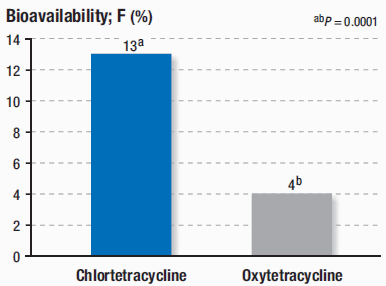
Distribution
Once absorbed into the bloodstream, an antimicrobial must then be distributed to the tissues, a process highly affected by two factors: the lipid solubility of the drug and the extent of protein binding.
High lipid solubility helps the drug cross the blood vessel wall and move into the target tissue, and also helps the drug reach ribosomes inside bacterial cells, thus increasing bacteriostatic efficacy. CTC has been demonstrated to be more lipid-soluble than OTC.1,2
Protein-binding is important because only free tetracycline molecules are able to cross through the blood vessel and move into the tissue. However, protein binding significantly impacts clinical efficacy only when the degree of binding exceeds 85 per cent to 90 per cent, and both CTC and OTC have protein binding levels less than this threshold.1,2
Drug distribution is described by a pharmacokinetic parameter called the apparent volume of distribution (Vd), an estimator of drug diffusion to tissues. The Vd of CTC is about 24 per cent greater than that of OTC (Figure 2), meaning that CTC distributes more readily in tissues.2
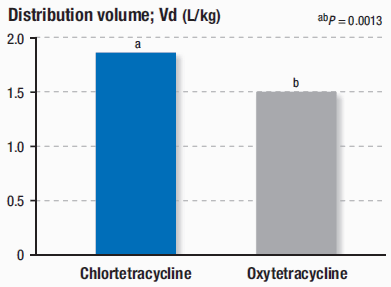
Drug Levels in Blood and Lungs
The superior bioavailability and distribution characteristics for CTC in swine help to explain why blood and lung levels are consistently higher for CTC than for OTC.
In one study, pigs averaging 30lb bodyweight (BW) were fed 364g per ton of either CTC or OTC.3 Blood and lung tissue samples were collected at 1, 3, 6, 12 and 24 hours after initiation of treatment. CTC blood levels averaged 50 per cent higher than OTC (Figure 3), and CTC lung tissue levels averaged 80 per cent higher than OTC (Figure 4).

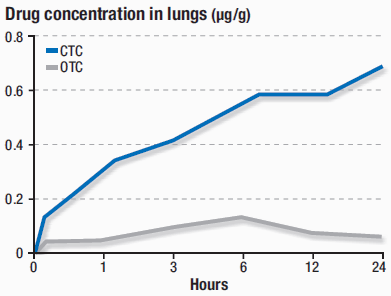
In another pharmacokinetics study, Swedish researchers4 fed 55-lb barrows CTC or OTC at a dosage of 50mg per kg BW (23mg per lb BW; approved dosage for OTC and CTC is 10mg per lb BW). Blood and lung tissue levels were assessed after 1 day and 4 days of treatment, with the samples collected six hours post-meal.
CTC generated blood levels 17- to 20-times higher than OTC blood levels, and CTC lung tissue concentrations were seven- to 11-times higher than OTC (Figure 5).
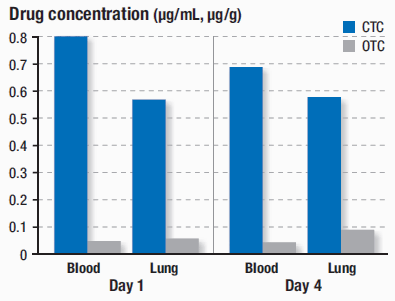
Researchers at South Dakota State University conducted a study evaluating blood levels of grower and finisher pigs fed CTC of OTC at three feeding levels (200, 400 or 800g per ton) with dietary calcium at either NRC (low) levels or NRC+ 50 per cent (high) levels.5
Pigs averaged 69lb at the finisher phase. Grower diets contained 16 per cent protein and 0.6 or 0.9 per cent calcium; finisher diets contained 14 per cent protein and 0.5 or 0.75 per cent calcium.
In general, feeding excessive calcium decreased CTC and OTC blood levels compared to pigs fed calcium at NRC levels (Figures 6 and 7). At each dosage and calcium level fed (except for one), grower and finisher pigs fed CTC demonstrated higher blood levels than pigs fed OTC.


Therapeutic Efficacy
Therapeutic distinctions between tetracyclines were investigated in a study where 85-lb pigs fed therapeutic 10mg per lb BW levels (600g per ton) of either CTC or OTC were challenged with Pasteurella multocida.6 A challenged, non-medicated control group was also evaluated. Treatments were initiated two days before challenge on day 0 and continued through day 10. The MIC of the challenge organism was the same for all groups.
Results reveal that blood levels for CTC-fed pigs were 70 per cent higher than the blood levels achieved in animals fed OTC (Figure 8). Average lung lesion score (i.e. percentage of abnormal lung tissue relative to healthy tissue) of pigs fed CTC was significantly reduced 54 per cent (P≤0.05) compared to non-medicated controls (Figure 9). While numerical lesion reduction was observed in OTC-fed pigs compared to controls, the difference was non-significant (P>0.05).
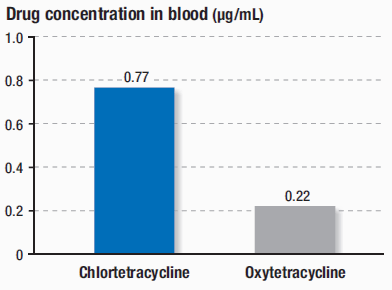
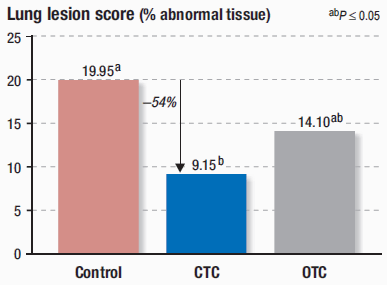
Performance outcomes during the 10-day challenge period are summarized in Figure 10. Average daily gain (ADG) of pigs fed CTC was significantly improved 61 per cent (0.34lb, P≤0.05) compared to non-medicated controls, while ADG improvement in OTC-fed pigs compared to controls was non-significant (P>0.05). Feed conversion efficiency (feed/gain) was numerically improved 51 per cent for pigs medicated with CTC compared to controls but only a modest seven per cent improvement was observed for the OTC-fed group.

Conclusions
The results of these studies show clear distinctions in pharmacologic and efficacy parameters between CTC and OTC when used in swine feeds.
- Bioavailability is three-fold greater for CTC than for OTC, indicating better absorption of drug from the gut of pigs.
- CTC is more lipid-soluble than OTC and protein binding for both drugs is clinically insignificant, so the volume of distribution of CTC is 24 per cent greater than that of OTC (CTC more readily distributes into body tissues).
- One study found that CTC blood levels averaged 50 per cent higher than OTC while CTC lung tissue levels averaged 80 per cent higher than OTC.
- In another study, CTC generated blood levels 17- to 20-times higher than OTC blood levels, and CTC lung tissue concentrations were seven- to 11-times higher than OTC.
In pigs challenged with Pasteurella multocida:
- Blood levels for CTC-fed pigs were 70 per cent higher than the blood levels achieved in animals fed OTC. The clinical relevance of this finding is unknown.
- Lung lesion scores were reduced by 54 per cent (P≤0.05) in pigs fed CTC compared to controls. Lesion scores in OTC-fed pigs were not statistically different than controls.
- ADG was improved by 61 per cent (P≤0.05) for pigs fed CTC while ADG for pigs fed OTC was not statistically different than controls.
References
1. del Castillo J. Metaphylaxis of bacterial respiratory problems. Pig Progress 1998.
2. del Castillo J, Elsener J, Martineau GP. Pharmacokinetic modeling of in-feed tetracycline in pigs using a meta-analytic compartmental approach. Swine Health Production 1998; 6(5):189-202.
3. Asanuma K, Shimazaki S, Hirata K. A study concerning the distribution of OTC and CTC in the lung and blood of pigs. J Animal Drugs (Getsukan Doyaku) 1984; 6(9):1-14.
4. Jacobson M, Franklin A, Fellstrom C. Comparison of blood and lung levels of antibiotics in swine given Aureomycin vet (CTC) or Terramycin vet (OTC) in the feed. Proc 13th IPVS Congress 1994; 358.
5. Libal GW, Hamilton CR, Weaver EM. Effect of therapeutic feeding levels of OTC and CTC dietary calcium on circulating antibiotic level of growing and finishing swine. SDSU Swine Day Proc Res Reports 1990; 37-41.
6. Sims MD. Investigator’s final report. Virginia Diversified Research Corporation (VRDC) 1998. Harrisonburg, VA.
August 2013









